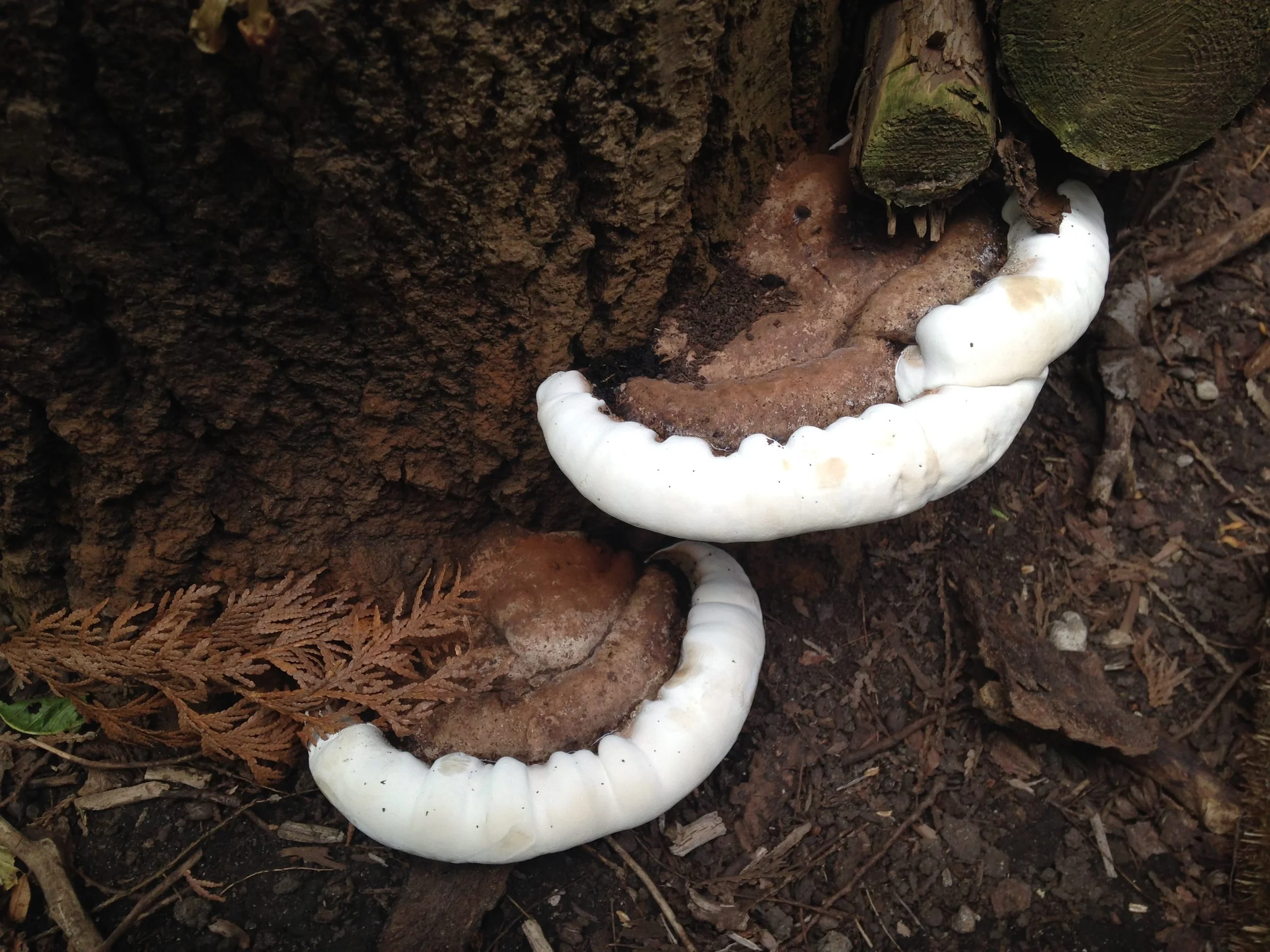Tracking the Smith Loop, 2022.09.05
hello,
i'd like to go tracking today. I'm going to head out this afternoon, maybe to smith trail because i just need to wander. want to come? i know it's last minute, so no pressure, but it would be fun to track with you.
carolyn
I was just thinking that I wanted to get out for a little and see what I could find, but I couldn’t decide where to go and I was in the midst of researching more about Carrion Beetles, specifically, the American Carrion Beetle (Necrophilus americanus). I needed a push and when Carolyn’s email arrived, I was stoked. It had been a while and she had also invited our friend Tamara, who is a really great naturalist and tracker whom I look up to. I was most definitely down to go.
A couple of hours later we were off the trail in the thick of a riparian Eastern White Cedar (Thuja occidentalis) woodland not too far from a heavily used looped trail just outside of Guelph. Some of the first things we noticed were tiny little feathers, which I did not get photos of, but were so small Tamara mentioned they looked similar to the scales of a Pine cone (Pinus spp.). We passed the feather around but I didn’t really take the time to notice too much as I was in the mood to find more Carrion Beetles, and since this was a wet-ish forest, it could be possible that we would find some. What Carolyn found caught my attention though: a skull. I love dead things, and here is the centerpiece.
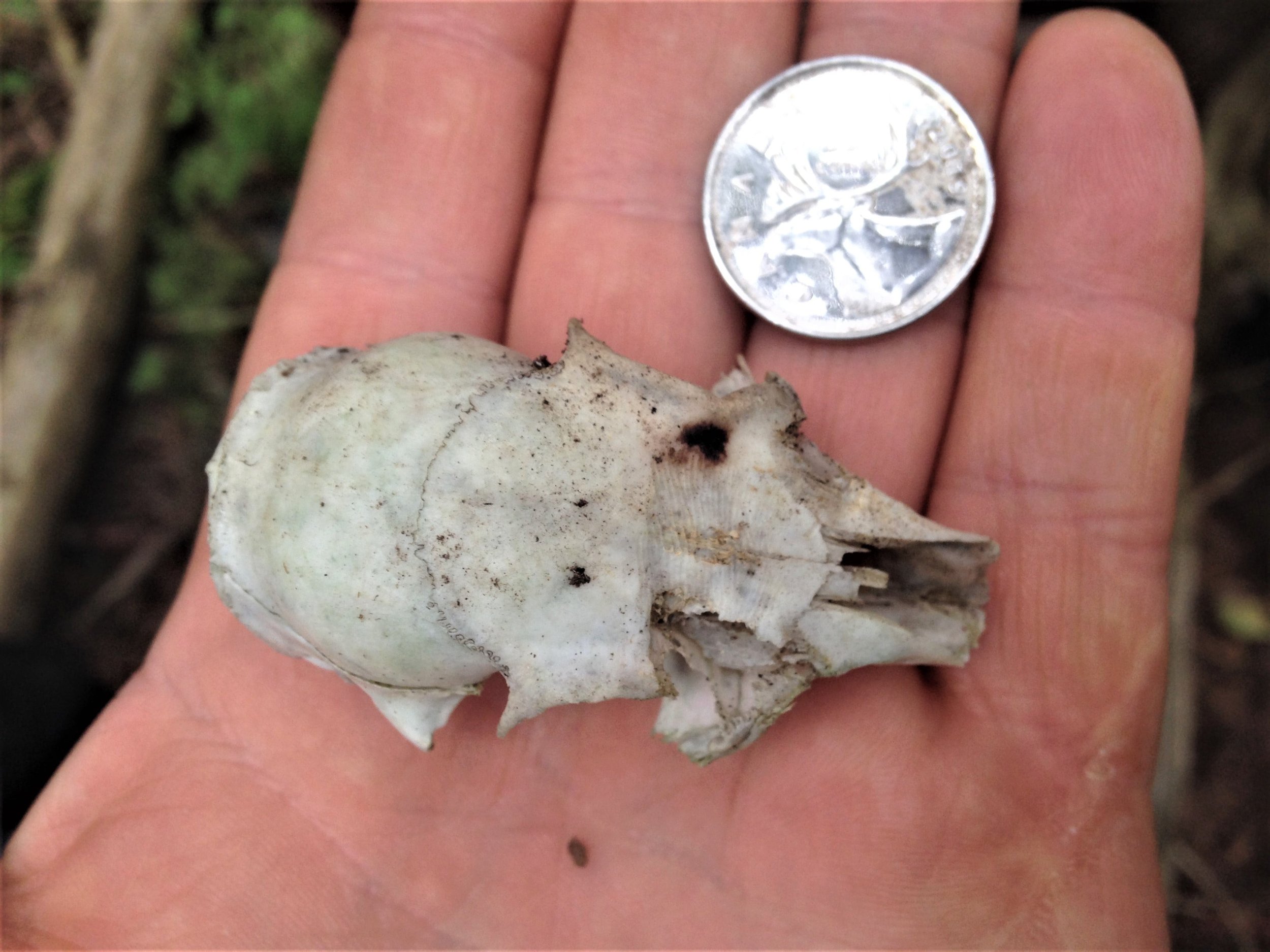
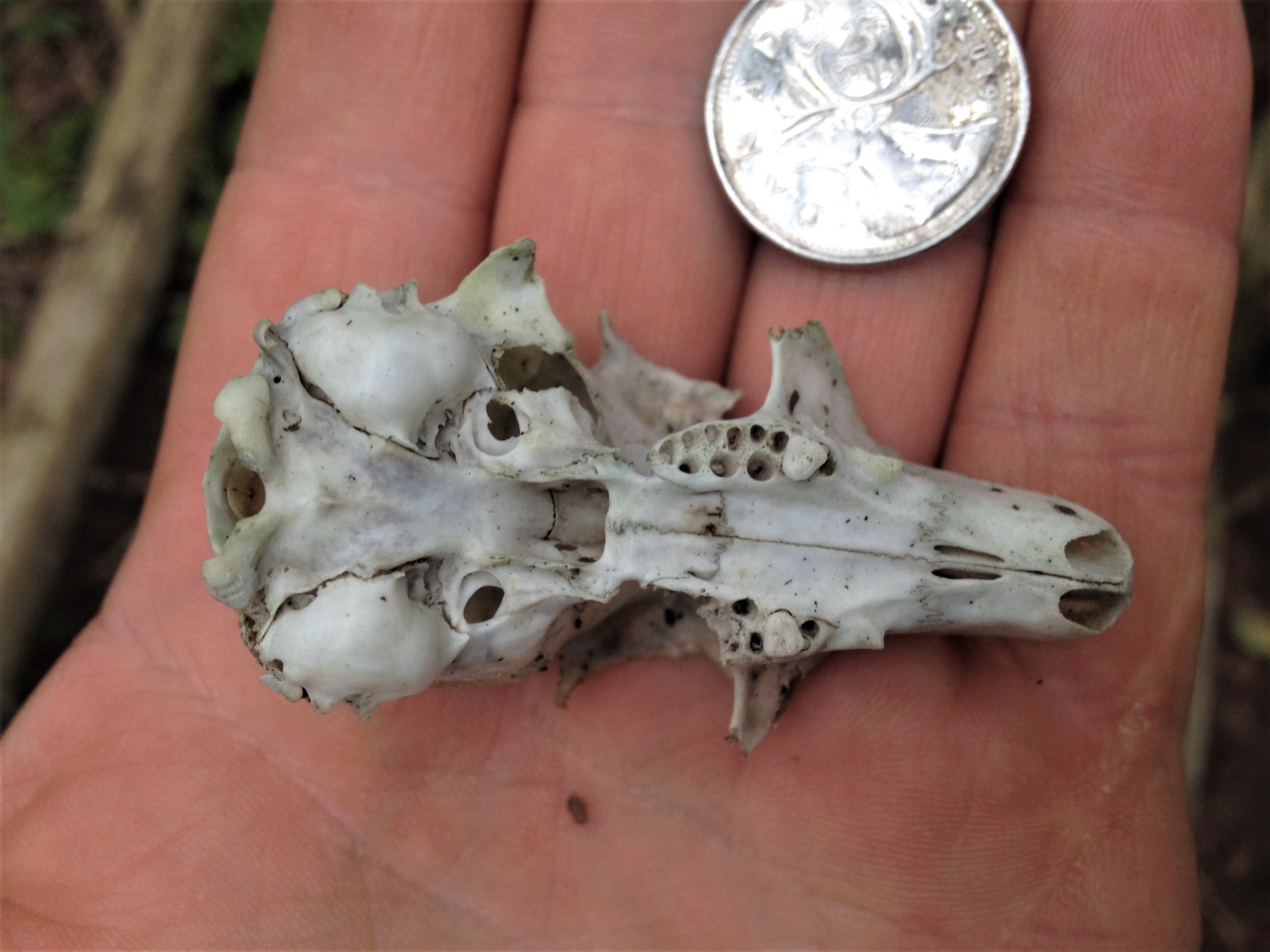
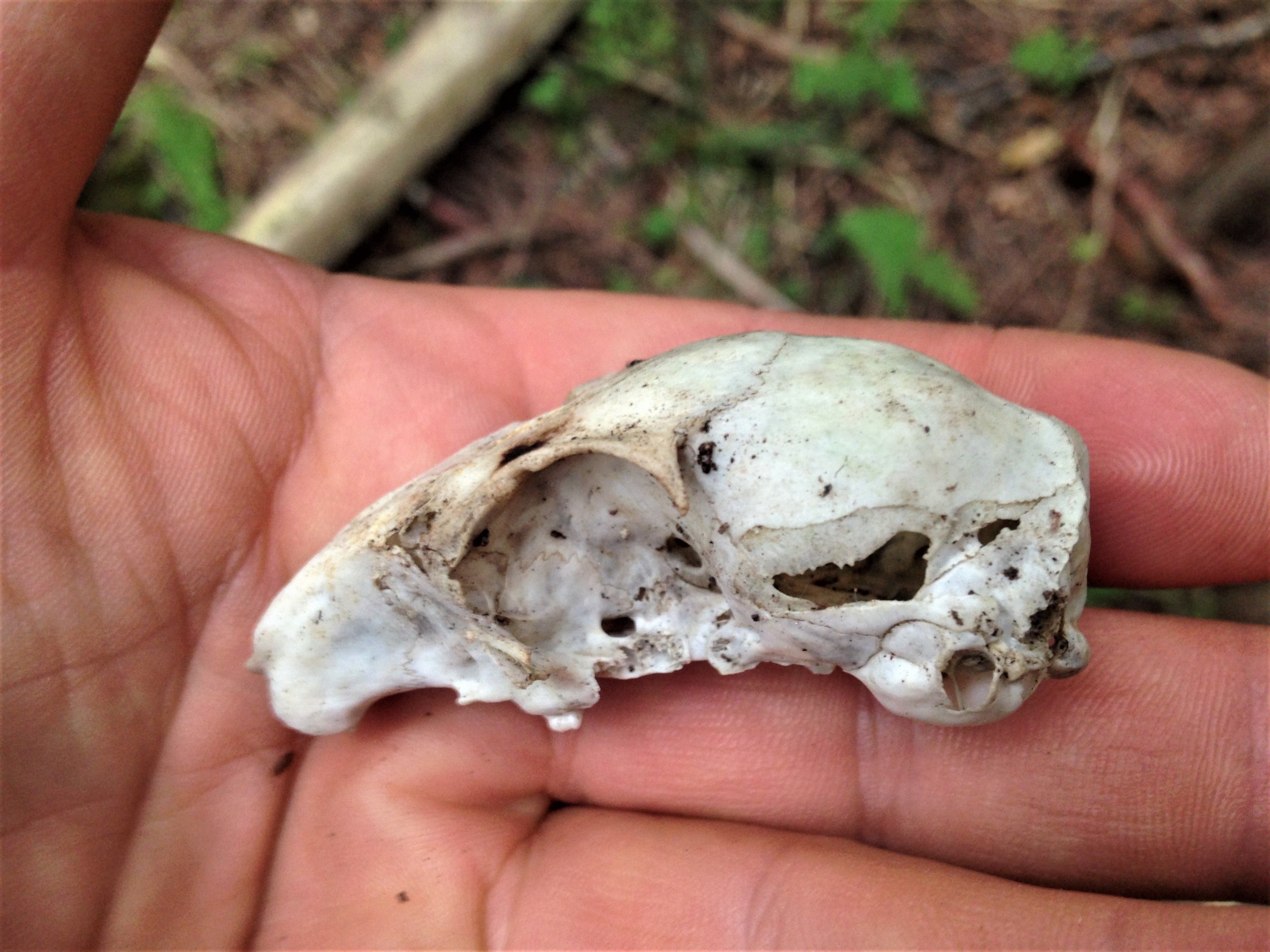
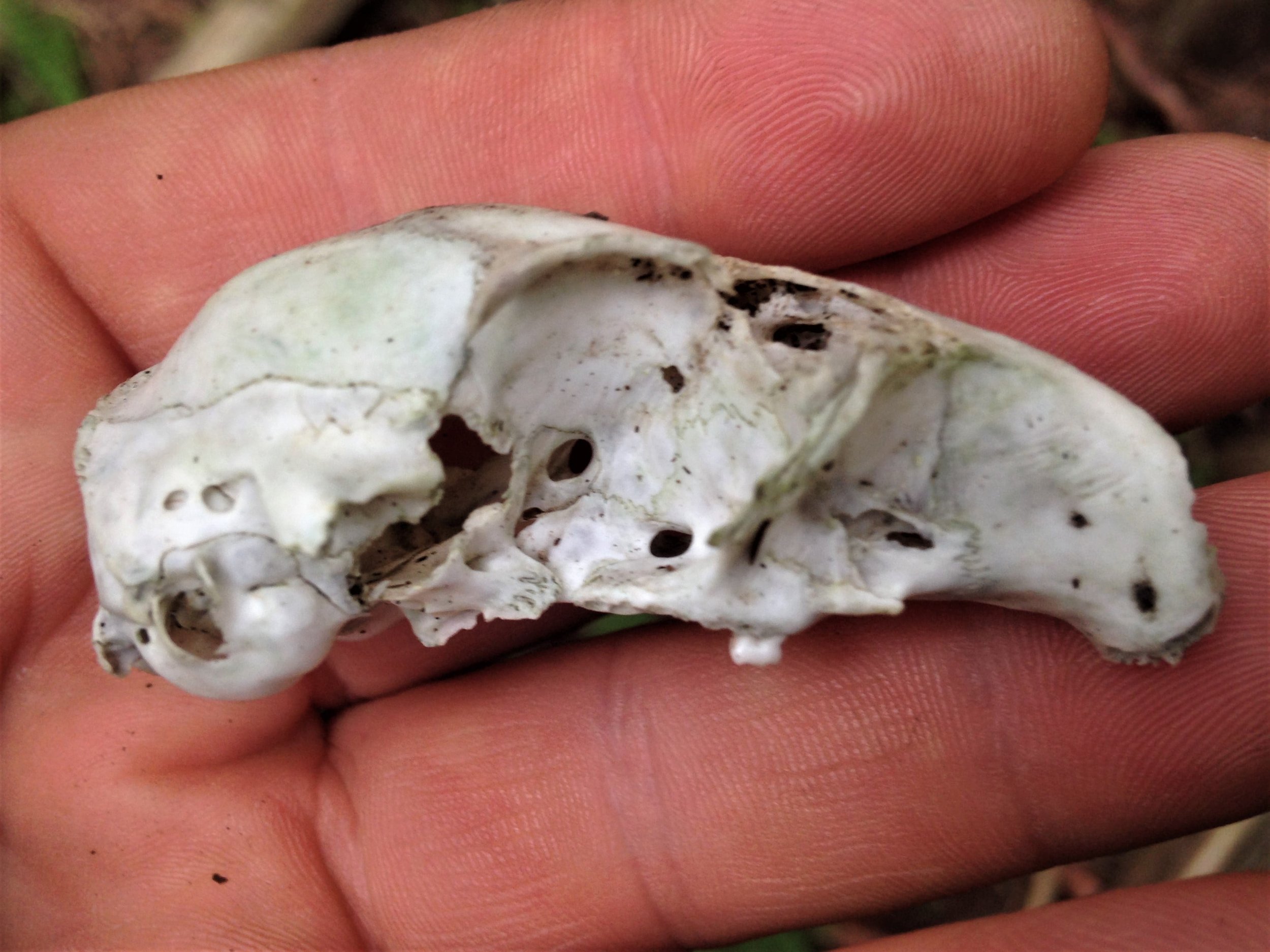
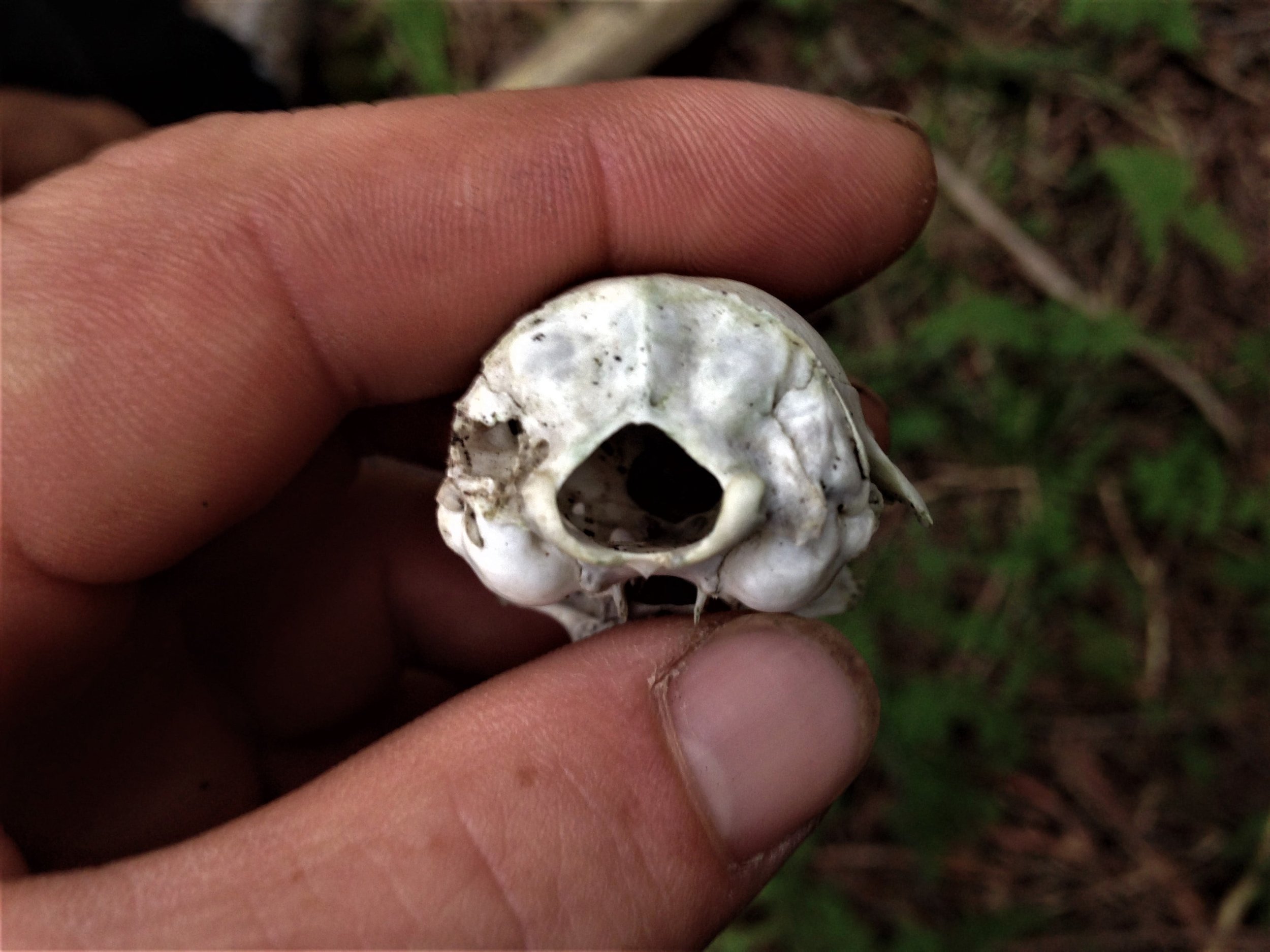
Some of the above images have been edited for clarity and brightness.
When Carolyn found the skull I quickly walked over to get a peek. When she handed it to me, I first noticed the size. It was small for a medium or large animal, and big for a small animal so it was likely a larger small animal, bigger than a Meadow Vole (Microtus pennsylvanicus), smaller than a Coyote (Canis latrans). Next I flipped it over and looked at the structure of the teeth and placement of the sockets. There were few, they were relatively flat, and far away from the large incisor sockets at the anterior (front) of the mouth. This taught me that this skull belonged to a rodent or lagomorph. I then looked at the incisive foramen, which are the two little holes just behind where the incisors would be. If this were a lagomorph like an Eastern Cottontail (Sylvilagus floridanus), the incisive foramen would be massive long holes taking up most of the palate. There are some rodents with similarly large incisive foramen, like a Muskrat (Onadatra zibethicus), so I could rule them out as well. I then looked up, away from the skull and out into the forest around me and asked myself the question of who lives in this particular forest whose skull would match the characteristics of the one in my hand? A rodent, but not a small one. First thing that came to mind was Squirrel. Sure. That would make sense. Cedar forest, busy with people and dogs.. Squirrel made sense. But which Squirrel? We have five (six if we want to be technical) Squirrel neighbours in our area so I had to determine which of them would have a skull like this one. The big four would be : Eastern Chipmunk (Tamias striatus), Red Squirrel (Tamiasciurus hudsonicus), Grey Squirrel (Sciurus carolinensis), Southern Flying Squirrel (Glaucomys volans) and Northern Flying Squirrel (Glaucomys sabrinus). The sixth one we could throw in there is a Groundhog (Monata monax) as they are in the Squirrel family, Sciuridae. So, among these who was it not?
I could discount the Groundhog due to the size of the skull. The skull in hand was about 60 mm long, which is too small for a Groundhog, whose lengths measure between 73.6 - 102 mm. It was also too big for a Red Squirrel (42.4 - 51.3 mm), Eastern Chipmunk (36.4 - 49.6 mm), Northern Flying Squirrel (36 - 44.2 mm), or Southern Flying Squirrel (32 - 37.2 mm). But it was within the range of an Eastern Grey Squirrel (53.8 - 66.5 mm). While I didn’t know these numbers in the field, I could guess based on what I have learned about the natural history of these animals and seeing most of them while they were alive. So considering the size, shape, location, dentition and incisive foramen, I came to the conclusion of Eastern Grey Squirrel. After checking the books, it still seems like a good guess.
We continued on until we came across a bit of a cleared depression in the soil where the leaf litter had been pulled away and the dark moist soil was visible. There were two actually, but with one a lot larger than the other, maybe about 37 cm in diameter for the larger depression, and some 17 - 20 cm for the smaller one. I looked for any tracks but with my novice eye I couldn’t make any out. Tamara began looking for and found some stray hairs amidst the soil. First thing we noticed were the banded lines of dark brown and white along the length of the hairs. Tamara had suggested a Raccoon (Procyon lotor) and even though I had skinned and salted a Raccoon hide many years ago, I did not keep any of the hairs as they began to fall out. In my research so far online, and in a book I have on mammal hairs, Raccoon doesn’t seem to fit the bill quite right. Most images I can find of Raccoon hair (1)(2) do show banding, but not as many bands throughout the length of the hair. Another animal I considered, on the off chance that we’d found something really special, was an American Badger (Taxidea taxus). American Badgers are endangered in Southern Ontario and it is always a present thought that if we find sign of any animals that might be threatened we could report it and perhaps protect the land we are tracking on. This is definitely a longshot, but it is worth considering all possible options. But it’s also important to remember what I have begun to call “byron’s rule”, which is something along the lines of “it’s always a Raccoon, unless it’s not” meaning that whenever there is the possibility of something being a Raccoon, it likely is a Raccoon as they are common, widespread, and prolific. In his book “The Hair Scale Identification Guide to Terrestrial Mammalian Carnivores of Canada” Justin Kestler writes that Badger hair can be described as “medium length, slightly wavy, banded”, all of which apply to the hairs Tamara found. In the entry on Raccoons he describes their hair as “medium/long, straight, banded”, which also mostly applies. The hairs we found may not be absolutely straight, weather, temperature and time could have changed the characteristics of the hair. Some of the examples I found online of Badger hair (1)(2) sort of fit the bill for the hair, but with such an unlikely find, I want to be pretty certain before I claim to know who it came from. I have reached out to an American Badger researcher in regards to whether the hairs are American Badger or not, but they have yet to reply.
As we made our way to the river, talk flowed from work to friendships to wildlife and our experiences over Summer. It was really nice to hang out with pals who love learning about the and can share some of the things in our lives while exploring the mysteries down by the river. I was reminded of a few years before when we were in the same forest with a friend who no longer lives on this side of the continent, and when I made a new friend. These tracking outings connect us with the land, and with each other in some really nice ways. I am grateful for every chance I get to go out with other folks and nerd out together.
Once at the river Carolyn and Tamara were intrigued by some possible Mink (Neogale vison) scat, but I wanted to check out the muddy bank. Along the Eramosa River there are a couple of good track traps of mud but actually not that many. I had been in this exact spot years before and found an abundance of Raccoon tracks, and they were certainly present again. I also noted Mink, Red Squirrel, and a mysterious bird track whom I could not sort out.
I looked at this track and wished I brought my tape measure, but I would guess, in comparison with the quarter placed beside it for scale that it is about 55 mm long. Toe 1 (the halux) is pointed directly back and has registered in the mud well enough to also get a good view of the claw. Toes 2, 3, and 4 are all pointed generally forward. I can’t quite tell which toes are 2 and 4 though as I do not know which side of the body this is on (toe 2 is always on the inside of the foot, 4 on the outside). I am also unsure if there is webbing between two of the toes or if toe 3 has a toe that is attached closer to the anterior of the foot. I have checked out the book Bird Tracks and Sign by Mark Elbroch and thought it may be a Common Grackle (Quiscalus quiscula) track at first, but I am doubting that now. A Grackle seems to have a bit of a curve in toe three towards the inside of the foot, and the metacarpal doesn’t really register that much, where as this track shows the whole foot. Grackles do hang out by the riverside hunting for Crayfish and other creatures, I just can’t confirm it was a Grackle which left this track. Perhaps it is just another mystery to hold..
Update (2022.09.10) : I have asked others online and some reliable sources also suggest Common Grackle, so maybe I was correct?
After the river we started making our way back to the trail. More stories of Summer and how we are getting ready for September teaching responsibilities. We moved at a leisurely pace and found a few small scats and a couple more feathers along the way. I did stop when I noticed a bone in the leaf litter a little ways away from the direction we were headed.
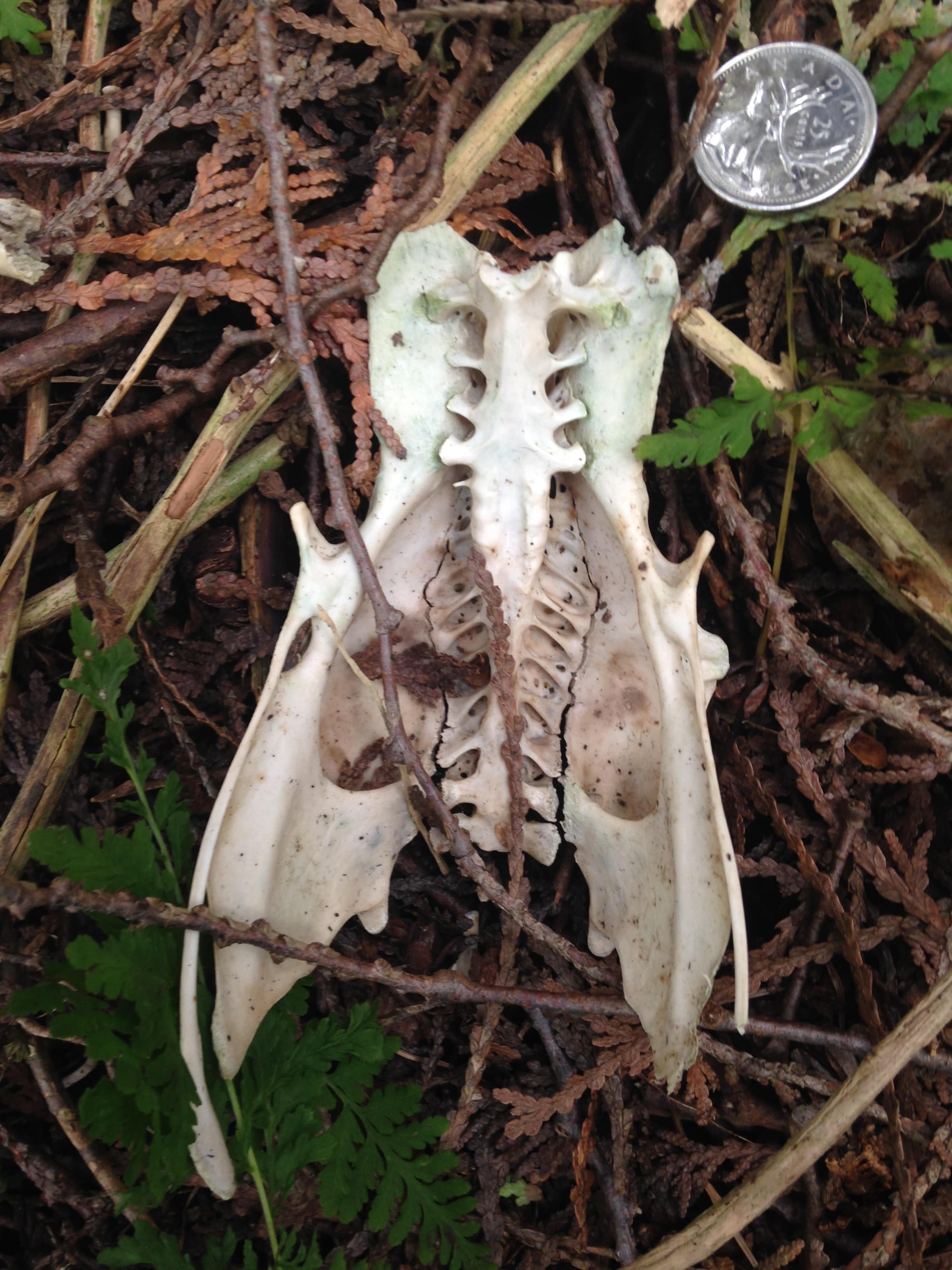
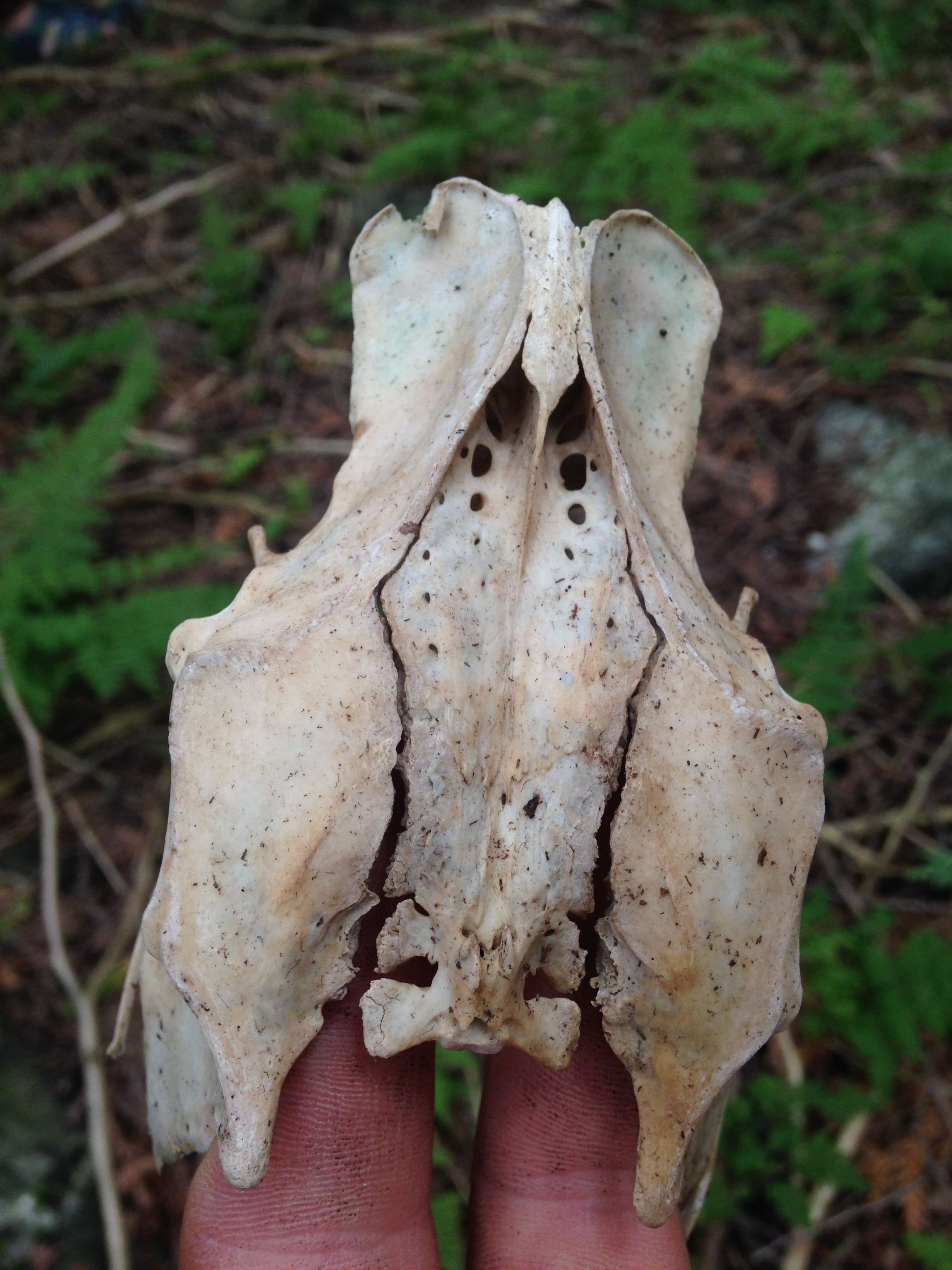

The bone was pretty big, about 11 cm long. I often find these cleaned in the woods as if any predator who took the animal who left it might not care for this much bone material without much meat. Perhaps that is a clue that this bone doesn’t have much meat on it when part of the living animal?
As I mentioned I have seen found this bone many times before and it is often confused for a skull and I can see how. It looks like it has two sockets for the eyes, what could be construed as top of a braincase, as well as a long rostrum. It would be a strange looking animal, but I can easily imagine how this could be confused for a skull. I first really learned about this bone though from examining a Crow (Corvus brachyrhynchos) carcass many years ago at the edge of a small White Pine (Pinus strobus) plantation. All of the feathers were strewn about but all that was left was this bone. I recognized that it was not a skull (missing many factors which I use for i.d.) but I had no idea where on the body it was located. I guessed that it had something to do with the vertebrae but I wasn’t certain.
I have since researched and come to understand that this bone is actually many bones fused together. It is the ilium, ischium and pubis along with seven vertebrae (six caudal vertebrae are missing from this specimen). The ilium is the long broad bones that make up most of the formation and is the bone closest to the top of the images on the right. The ischium are the lower “wings” that come out from the central vertebrae and the pubis are the long, thin bones which stretch out the bottom of this fused structure. These are the pelvic girdle. The vertebrae, all fused are called the synsacrum, and is only found in modern birds (as opposed to prehistoric birds, reptiles, or mammals). Why are all these bones fused? This fusion makes it easier for the bird to walk and to fly, only having to keep the one larger bone structure rigid rather than many individual bones. It’s a genius move of evolution.
But what bird did it come from? That is a question I cannot solve yet. I wonder if you can tell the species from the shape or width of the bone? Maybe I could get to the bird type, Goose, Duck, Songbird, etc. from the size but I have not heard or read anything about it yet.
As we were heading out we stopped to check out a polypore mushroom growing out of the base of what I believe was an old Trembling Aspen (Populus tremloides) stump near the trailhead. I noticed the fat puffy white rim growing around the brown old crusty stuff and I had to get a photo.
I have heard or read somewhere that the puffy white edge is this year’s growth. This is producing new pores from which spores will emerge. I think of my errors in identification of polypores like this one is because I have used this white edge as an identification feature where so many species have this characteristic. It is always important to observe where a fungi is growing, as in the habitat and the substrate. Again this was a lowland Cedar forest, in Southern Ontario, on what I believe to be a Trembling Aspen stump. This info helps to narrow my possibilities but not by much. I tried checking out all of mushroom books, but none can give me an i.d. which I feel confident about so I checked out inaturalist. The suggestions inaturalist provided didn’t quite make sense. Near the top of the list was Ganoderma applanatum commonly known as Artist’s Conk. Artist’s Conk is generally more grey on the top, and flatter. According to Micheal Kuo at mushroomexpert.com, G. applanatum is perennial, meaning the same mushroom will grow year after year, like a tree is perennial. A different species, Ganoderma lobatum, which looked a little more like the one I found, and was in the top 5 on inaturalist, the fruiting body dies after one to three years of growth. When we were observing this mushroom on the trail, Tamara had commented that the brown crusty stuff kind of looked like previous years growths, which would make sense. One interesting way to tell the two apart is a thumb test. That means trying to press firmly into the previous years growths with only the pressure from your thumb. This should be enough to break through the crusty brown stuff on a G. lobatum, but not on a G. applantum. I didn’t know this before and now I am going to have to make a plan to return to this site and try it out. Ganoderma lobatum is known to be saprobic, meaning they feed on dead or decaying trees, and in the case of G. lobatum that means dead or decaying hardwood, like the stump where it was growing. G. lobatum causes white-rot in the wood it is consuming, which is the process of fungi digesting cellulose and the extremely durable lignin parts of the wood and demonstrates by leaving behind stringy fibrous strand-like pieces of pale cellulose. White rot breaks things down a little more thus freeing up more nutrients trapped in the wood. I often find this to be really spongy in the way it holds moisture. There is also a species called Ganoderma lobatoideum, which looks very similar to G. lobatum, but is found further South of where I am at, and the spores are slightly smaller (I don’t have a microscope to see that). As a side note, whenever you see -oides, or oideum, or something like that in a scientific binomial it means “looks like”. Think of “humanoid” meaning looks a human, or “asteroid” meaning looks like a star.
So many mysteries in one short trip out to the woods, with three knowledgeable naturalists and trackers. It is amazing what we don’t know, and what we will never know. These mysteries will enliven my days with wonder and joy and if a time finally comes that something is revealed and I am to know who I have encountered, I will be blessed again with more questions and more wondering and more awe.
Big thanks to Carolyn and Tamara for a wonderful outing.
To learn more :
Animal Skulls by Mark Elbroch (Stackpole Books, 2006)
Video on the structure of the synsacrum
Manual of Ornithology by Noble S. Proctor and Patrick J.. Lynch (Yale University Press, 1993)
Handbook of Avian Anatomy
Bird Tracks and Sign by Mark Elbroch (Stackpole Books, 2001)
Mushroomexpert.com page on Ganoderma lobatum



